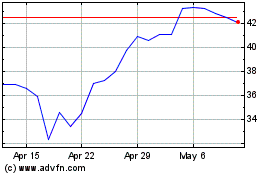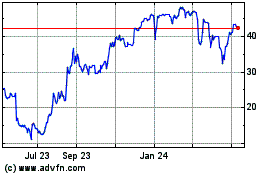Belite Bio Announces PMDA Submission of Tinlarebant for Stargardt Disease Clinical Trial in Japan
March 22 2024 - 8:00AM

Belite Bio, Inc (NASDAQ: BLTE) (“Belite Bio” or the “Company”), a
clinical-stage biopharmaceutical drug development company focused
on advancing novel therapeutics targeting degenerative retinal
diseases that have significant unmet medical needs, today announces
its submission to the Pharmaceuticals and Medical Devices Agency
(PMDA) to initiate a clinical trial of Tinlarebant in adolescent
STGD1 in Japan (“DRAGON II”).
The DRAGON II trial is a combination of Phase 1b
open-label study to evaluate the pharmacokinetics and
pharmacodynamics of Tinlarebant in Japanese adolescent STGD1
subjects and a Phase 2/3, global, multicenter, double-masked,
placebo-controlled, randomized study designed to evaluate the
efficacy, safety and tolerability of Tinlarebant in adolescent
STGD1 subjects. Approximately 60 subjects, aged 12 to 20 years old,
including approximately 10 Japanese subjects, are targeted for
enrollment in the Phase 2/3 portion of the trial with a 1:1
randomization (tinlarebant:placebo). The data from Japanese
subjects is intended to facilitate future NDA applications in
Japan.
About Tinlarebant (a/k/a
LBS-008)
Tinlarebant is a novel oral therapy that is
intended to reduce the accumulation of vitamin A-based toxins
(known as bisretinoids) that cause retinal disease in STGD1 and
also contribute to disease progression in GA, or advanced Dry AMD.
Bisretinoids are by-products of the visual cycle, which is
dependent on the supply of vitamin A (retinol) to the eye.
Tinlarebant works by reducing and maintaining levels of serum
retinol binding protein 4 (RBP4), the sole carrier protein for
retinol transport from the liver to the eye. By modulating the
amount of retinol entering the eye, Tinlarebant reduces the
formation of bisretinoids. Tinlarebant has been granted Fast Track
Designation and Rare Pediatric Disease designation in the U.S., and
Orphan Drug Designation in the U.S., Europe, and Japan for the
treatment of STGD1.
Stargardt Disease (STGD1)
STGD1 is the most common inherited retinal
dystrophy (causing blurring or loss of central vision) in both
adults and children. The disease is caused by mutations in a
retina-specific gene (ABCA4), which results in progressive
accumulation of bisretinoids leading to retinal cell death and
progressive loss of central vision. The fluorescent properties of
bisretinoids and the development of retinal imaging systems have
helped ophthalmologists identify and monitor disease progression.
Currently, there are no FDA approved treatments for STGD1.
Importantly, STGD1 and GA, or advanced Dry AMD,
share a similar pathophysiology, which is characterized by the
excessive accumulation of bisretinoids, retinal cell death, and
progressive loss of vision. Vision loss occurs slowly, despite
peripheral expansion of “dead retina,” until the disease reaches
the center of the eye (the macula). Therefore, Belite Bio is
evaluating safety and efficacy of Tinlarebant in GA patients in a
2-year Phase 3 study (PHOENIX).
GA in advanced Dry Age-related Macular
Degeneration (Dry AMD)
Dry AMD is a leading cause of vision loss in
older adults. Geographic Atrophy, or GA, is the advanced stage of
AMD. Currently, there are no FDA approved orally administered
treatments for GA and no FDA approved therapies for the other
stages of Dry AMD other than GA. There are an estimated 20 million
AMD patients in the U.S. and over 196 million patients worldwide
with an estimated global direct healthcare cost of US$255
billion.
About Belite Bio
Belite Bio is a clinical-stage biopharmaceutical
drug development company focused on advancing novel therapeutics
targeting retinal degenerative eye diseases which have significant
unmet medical needs such as (i) atrophic age-related macular
degeneration (AMD), commonly known as Geographic Atrophy (GA) in
advanced dry AMD, and (ii) autosomal recessive Stargardt disease
type 1, or STGD1, in addition to specific metabolic diseases. For
more information, follow us on Twitter, Instagram, LinkedIn,
Facebook or visit us at www.belitebio.com.
Important Cautions Regarding Forward Looking
Statements
This press release contains forward-looking
statements about future expectations and plans, as well as other
statements regarding matters that are not historical facts. These
statements include but are not limited to statements regarding the
potential implications of clinical data for patients, and Belite
Bio’s advancement of, and anticipated preclinical activities,
clinical development, regulatory milestones, and commercialization
of its product candidates, and any other statements containing the
words “expect”, “hope” and similar expressions. Actual results may
differ materially from those indicated in the forward-looking
statements as a result of various important factors, including but
not limited to Belite Bio’s ability to demonstrate the safety and
efficacy of its drug candidates; the clinical results for its drug
candidates, which may not support further development or regulatory
approval; the timing to complete relevant clinical trials and/or to
receive the interim/final data of such clinical trials; the content
and timing of decisions made by the relevant regulatory authorities
regarding regulatory approval of Belite Bio’s drug candidates; the
potential efficacy of Tinlarebant, as well as those risks more
fully discussed in the “Risk Factors” section in Belite Bio’s
filings with the U.S. Securities and Exchange Commission. All
forward-looking statements are based on information currently
available to Belite Bio, and Belite Bio undertakes no obligation to
publicly update or revise any forward-looking statements, whether
as a result of new information, future events or otherwise, except
as may be required by law.
Media and Investor Relations
Contact:Jennifer Wu
/ir@belitebio.comJulie Fallon /
belite@argotpartners.com
Belite Bio (NASDAQ:BLTE)
Historical Stock Chart
From Apr 2024 to May 2024

Belite Bio (NASDAQ:BLTE)
Historical Stock Chart
From May 2023 to May 2024
